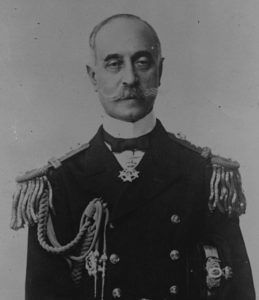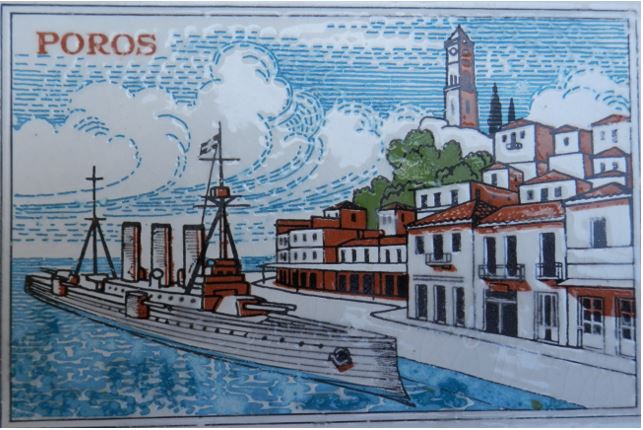- Author
- Editorial Staff
- Subjects
- History - general, Ship histories and stories
- Tags
-
- RAN Ships
- None noted.
- Publication
- December 2022 edition of the Naval Historical Review (all rights reserved)
Found in a Charity Shop
Within the folds of gentle green hills and quiet countryside of mid-Wales, far removed from the sea, lies St David’s College Lampeter, part of Britain’s smallest university. The college, now celebrating its 200th anniversary, was established as a seminary for the Anglican priesthood. Previously students came from English universities with few speaking the Welsh language of their congregations. In a nearby charity shop your correspondent found a ceramic plaque depicting an old warship with a background of sundrenched whitewashed buildings with bright terracotta roofs. The only identification was the name Poros. And so with an investment of £1/10 or $AUD 2.50 our quest commenced.
A quick review of a gazetteer informs us that Poros is a small island not far from Athens, and Jane’s reveals this ship to be the Royal Hellenic Navy armoured cruiser Georgios Averoff, commissioned in 1911 and which most surprisingly remains in commission to this day. She was one of three sisters of the Pisa class ordered for the Italian Regia Marina. Budget constraints forced the cancellation of one of the class which was bought off the stocks of Orlando Shipyard at Livorno with a down-payment in gold of £300,000 (today $AUD 42m) from a bequest by Georgios Averoff, whose name she consequently received. This bequest covered nearly one third of the final cost of £950,750, the remainder being covered by the Greek government.
The Benefactor

Georgios Averoff (1815–1899) was a Greek businessman who lived in Egypt, becoming one of the country’s leading merchants and amassing a vast fortune. The Averoff family’s roots were Aromanian from ancient Greece which had become part of the Ottoman Empire, but its people, mainly Orthodox Christians, were ardent nationalists. As a philanthropist Georgios indulged in this passion for Greek nationalism and contributed to many worthwhile causes including the founding of schools and universities, the Greek military academy, and the modern Olympic Games. He also bequeathed funds for a Greek naval training ship.
The Royal Hellenic Navy Ship Georgios Averoff
Georgios Averoff was not known by her full name and became just Averoff (pronounced AV-AIR-OFF). She was laid down in 1907, launched on 12 March 1910, and commissioned on 16 May 1911. As it transpired, she was the last armoured cruiser in the world to be commissioned, with this class of warship rendered obsolete by the battlecruiser. With her distinctive three funnels she displaced 10,118 tons and had a complement of 670 men. The main armament comprised 4 x 9.2 inch and 8 x 7.5 inch guns with a secondary armament of 18 x 12 pounders, and she had 3 x 18-inch torpedo tubes. Twenty two coal fired boilers powered two sets of 4-cylinder triple expansion engines providing 20,000 HP, driving two screw propellers, and giving a top speed of 23 knots. This mixture of Italian engines, French boilers, German generators and British guns, worked rather well and Greece then possessed the most advanced warship in the Aegean.
The First Commission
Shortly after commissioning her first captain, Ioannis Damianos, took his ship to England for the Coronation Naval Review of King George V. The visit was troubled as in thick fog the ship ran aground requiring extensive repairs. Her crew were then involved in a large brawl with locals, and finally there was a mutiny where her crew demanded the removal of four unpopular officers. The outcome of this was that Captain Damianos, the four officers, and eight ringleaders were sent home. Command was given to Captain Pavos Kountouriotis.
With rigorous training, especially in gunnery exercises, conducted on her homeward voyage the rebellious sentiment was forgotten and the flagship anchored off the waterfront of Phaleron, south of Athens, on 1 September 1911. She was greeted by a milling horde of craft of all sizes and Crown Prince Constantine conducted a formal inspection.
The First World War
At the start of the 20th century the once mighty Ottoman Empire was drawing to a close. Nationalist revolts and incursions by aggressive new powers were threatening her borders. In one last gasp the Turkish Navy had begun a system of modernisation under British Admiral Sir Douglas Gamble. The Turks also received two second-hand German battleships. But later the Turkish cause was severely compromised when two new dreadnoughts they had building in Britain were requisitioned by the Royal Navy.

The first show of force by Rear Admiral Kountouriotis took place at Mudros Bay on the Turkish-held island of Lemnos on 6 October 1912. Averoff turned her guns on the main port and demanded a surrender. When the Turks refused the destroyer Doxa with a battalion of marines occupied Lemnos which the Turkish garrison abandoned. With this first victory morale skyrocketed and afterwards Turkish-held islands began falling one after another to the threat of Greek guns.
The Turkish fleet had been cooped up sheltering under its forts in the Dardanelles and on 1 December 1912 put to sea to encounter the Greek fleet. While the subsequent engagement was inconclusive and damage and casualties were suffered by both sides, the Turks suffered most and withdrew. Therefore, the Battle of Cape Helles became a great Greek victory.
The two opposing forces met again in open waters on 5 January 1913 when one Turkish ship was sunk and there were about 500 casualties; incredibly there were no Greek casualties and the Turkish fleet withdrew. With this victory Greece was master of the Aegean Sea, and so ended the First Balkan War with Turkey obliged to sue for peace and cede sovereignty of many of its islands to Greece. In a few short years Greece had almost doubled its territorial claims and had the most formidable navy in southeast Europe. Throughout these actions Averoff, suffered only minor damage but inflicted severe punishment on her enemies. For this reason, she was known by the nickname ‘Lucky Uncle George’.
Following victory in the First World War, in January 1919 in a symbolic show of strength Averoff steamed into Constantinople, after an absence of more than 500 years of Byzantine power. This was to be the high point for the Greek independence.
In May 1919 Averoff was off Smyrna supporting Greek landings on the Turkish mainland. This dream of a return to a Greek Empire would be brief and was soon repulsed by the ‘Young Turks’ led by Mustafa Kemal and resulted in large numbers of Greeks being driven from the region.
On 19 December 1923 after much unrest between monarchists and republicans King George II was forced to resign and the venerated, now 70 years old, Admiral Koundouriotis took over as Regent and later President.
The aging Averoff was given a new lease of life with a modernisation at Toulon, France during 1925 to 1927 when anti-aircraft armament and fire control systems were fitted, but the cost of conversion to oil fuel was considered prohibitive.
In 1935 Greece was once again in revolt with warring factions and the navy divided into two camps. With British and French assistance an uneasy peace was restored and the royal family returned under King George II. Shortly afterwards in a repeat of events in 1911 the grand old lady was again sent to Spithead to mark the 1935 Silver Jubilee of the reign of King George V. Averoff was the only warship present to have taken part in the 1911 and 1935 reviews.
Second World War
With the advent of the Second World War an expansionist Italy cast envious eyes on Greek islands and in July 1940 Italian aircraft attacked Greek cities and ships, and an Italian submarine torpedoed the Greek cruiser Elli. The main task of the RHN was to escort troopships from the islands to the mainland. Moored at Eleusis Bay, Averoff was kept out of harm’s way. In what was primarily an army war the Greeks more than held their own against the Italians. This all changed in April 1941 when German columns supported by the Luftwaffe smashed through Greek and British defences. Then came the demoralising exodus of troops to Crete.

While Greek ships were to join convoys making for Crete and thence Alexandria, Averoff was considered too old to join and in consultation with the British Admiralty she was to be scuttled. But this was not to be the end of this gallant ship – her crew were given the opportunity of staying with the ship or escaping ashore. Most of the older men with families choose the latter option but some 300 younger men without ties remained, and headed by her Gunnery Officer Lieutenant Commander Papavasiliou Damilatis in provisional command made for sea. This was thwarted by a boom gate which the guard refused to move, so the Averoff crew took matters into their own hands, hacked through the thick cables securing the boom gates and were on their way.
The old but proud cruiser, prone to mechanical faults, was considered unsuitable to engage in warfare in the Mediterranean theatre so she spent the next three years as a convoy escort and guard ship in the Indian Ocean. To ease manning issues, she was given support with Indian stokers taking over the demanding coal fired boilers. In an unfortunate episode while in the Indian Ocean, in March 1942 Captain Nikolnos Petropoulos assumed command. He was a capable officer but a martinet who demanded instant acceptance of his orders. The grim corporal punishment that he insisted be carried out on a deserter resulted in a revolt by his junior officers. Captain Petropoulos was removed from command but to maintain discipline 30 officers were court-martialled, receiving goal sentences. This was not the end of her problems, with discontent continuing.
Captain Theodore Koundouriotis, a son of the renowned admiral, was appointed in command. In October 1944 ‘Uncle George’ set out on a triumphant voyage home with the honour of conveying the Greek government in exile from Cairo to a liberated Athens.
In 1952 she decommissioned before moving to Poros, near Athens, where she was berthed from 1956 to 1983. After a further period of political unrest in 1973 the Greek monarchy was abolished and a republic claimed, meaning that the Royal Hellenic Navy was now the plain Hellenic Navy. From 1984 until today Averoff has been reinstated on active duty as a museum ship in Faliro near Athens.
Summary
How and when a young seminarian set out on a journey to Rome, Athens and the Holy Land and visited Poros shall most likely remain unknown. This does however reveal a fascinating short history of the modern Greek state and how the vision of one patriot helped influence the composition of a fleet during an important stage when it possessed the most advanced warship in the region. Georgios Averoff remains a truly magnificent ship and the Greek authorities are to be congratulated on having her as a centrepiece in their maritime museum.
References
Carr, John C., RHNS Averof – Thunder in the Aegean, Pen & Sword Maritime, Barnsley, 2014.
Biography of Georgios Averoff https://en.wikipedia.org/wiki/George_Averoff
The Greek naval ship Georgios Averoff https://en.wikipedia.org/wiki/Greek_cruiser_Georgios_Averof
History of the Hellenic Navy https://en.wikipedia.org/wiki/History_of_the_Hellenic_Navy
History of Lampeter Campus https://uwtsd.ac.uk/bicentenary/history-of-the-lampeter-campus/
Jane’s Fighting Ships, Sampson, Low, Marston, London, various dates.
Lellos, Leonidas B., Greece: History, Museums: Monuments, Ministry of Culture & Sciences, Athens, 1972.




